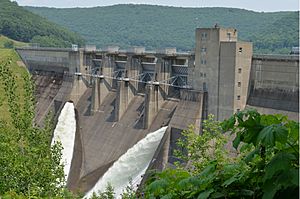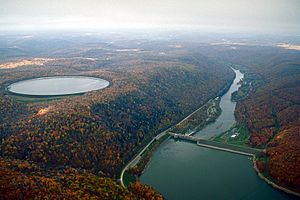Kinzua Dam facts for kids
Quick facts for kids Kinzua Dam |
|
|---|---|

Kinzua Dam in July 2015
|
|
| Official name | Kinzua Dam |
| Location | Allegheny National Forest Glade Township / Mead Township, Warren County, Pennsylvania, United States |
| Coordinates | 41°50′16″N 79°0′11″W / 41.83778°N 79.00306°W |
| Construction began | 1960 |
| Opening date | 1965 |
| Operator(s) | Army Corps of Engineers |
| Dam and spillways | |
| Impounds | Allegheny River |
| Height | 179 feet (55 m) |
| Length | 1,897 feet (578 m) |
| Width (base) | 1,245 feet (379 m) |
| Reservoir | |
| Creates | Allegheny Reservoir |
| Total capacity | 1,300,000 acre-feet (1.6 km3) |
| Active capacity | 573,000 acre-feet (0.707 km3) |
The Kinzua Dam is a very large dam built on the Allegheny River in Pennsylvania. It's one of the biggest dams east of the Mississippi River in the United States. You can find it inside the beautiful Allegheny National Forest.
The dam is about 6 miles (10 km) east of Warren, Pennsylvania, along Route 59. It sits within the huge 500,000-acre (200,000 ha) Allegheny National Forest. The dam helps control floods and create electricity. It also formed Allegheny Reservoir, which is Pennsylvania's second deepest lake. This lake is also known as Kinzua Lake. A smaller lake called Quaker Lake also formed because of the dam.
The Allegheny Reservoir stretches 25 miles (40 km) north, almost reaching Salamanca, New York. This area is part of the Allegany Reservation of the Seneca Nation of New York. Building the dam meant that the government had to take land from the Seneca people. More than 600 Seneca members had to move, and their reservation lost about 10,000 acres (4,000 ha), which was nearly one-third of their land and much of their good farmland.
Contents
Building the Kinzua Dam
In 1936, a very big flood hit the Pittsburgh area and caused a lot of damage. Because of this, the government decided to build a dam on the Allegheny River. The US Army Corps of Engineers started building the Kinzua Dam in 1960. It was finished in 1965, and the reservoir was completely filled by 1967.
Many people, especially the Seneca Nation of Indians in New York, were against the dam. They were worried because the dam would flood their lands to create a lake for fun and power. This meant they would lose most of their historic Cornplanter Tract in Pennsylvania, along with many communities and thousands of acres of rich farmland in New York. Over 600 families had to leave their homes and move.
The main reason for building the dam was to stop floods on the Allegheny River. The Kinzua Dam controls water from a huge area of 2,180 square miles (5,600 km²). This area is twice the size of the state of Rhode Island! The Army Corps of Engineers also said the dam would help with droughts, make hydroelectric power, and offer places for recreation. The electricity made here mostly goes to Pittsburgh.
Dam Facts and Figures
The Kinzua Dam is a very impressive structure. Here are some interesting facts about it:
- The dam is 1,877 feet (572 m) long.
- Its tallest point is 179 feet (55 m) high.
- It used 3 million cubic yards (2.3 million m³) of earthfill.
- It also used 500,000 cubic yards (380,000 m³) of concrete.
- Inside the dam, there are eight large pipes (called sluices) and two special pipes (called penstocks) that are 15 feet (4.6 m) wide. These pipes help control water flow and generate power.
- The dam can produce 400 megawatts of hydroelectric power.
- The total cost to build the dam was about $108 million.
The Kinzua Dam is the largest concrete and earth-fill dam in the eastern United States.
How the Dam Helps the Economy
The Kinzua Dam cost about $108 million to build. However, it has saved a lot more money than it cost. For example, in 1972, when Hurricane Agnes caused heavy rains, the dam prevented an estimated $247 million in flood damages downstream. Since it started working, the dam has prevented about $1 billion in flood damages.
Seneca Pumped Storage Generating Station
Right next to the dam, on the downstream side, is the Seneca Pumped Storage Generating Station. This is a special power plant that uses water to store energy. It pumps water into a higher reservoir when there's extra electricity available. Then, when a lot of electricity is needed, the water is released back down. As it falls, it spins generators to make power. This helps provide electricity when people need it most.
Fun Activities at Kinzua Lake
The Allegheny Reservoir, also known as Kinzua Lake, and the areas around it are great for many outdoor activities. You can go camping, hiking, snowmobiling, and boating. The United States Forest Service has created four developed campgrounds and five simpler camping areas that you can reach by boat or hiking.
There are also several scenic viewpoints with miles of hiking trails and information centers along the reservoir. Much of the Allegheny National Recreation Area is around Allegheny Lake. The Seneca Nation also has a developed campground on their reservation at the northern end of the reservoir in New York.
People and Communities Affected by the Dam
Seneca Land and Relocation
Building the Kinzua Dam meant that 10,000 acres (4,000 ha) of the Allegany Reservation were taken. This was almost one-third of the Seneca Nation's land. This land had been given to the Seneca nation in the Treaty of Canandaigua, signed by President Washington. The Seneca lost a lot of their good farmland, and 600 Seneca people had to move from their homes on the reservation.
In 1961, President John F. Kennedy said the dam was urgently needed for flood control and denied the Seneca's request to stop construction.
After moving, the lives of the displaced Seneca people changed a lot. Many Seneca tribe members, especially those living in the flood area, had lived simply without modern things like electricity. Two new living areas were built for them: Jimersontown and an area south of Steamburg. These new places had modern conveniences. This forced change is one reason why some Seneca people still feel upset about the dam.
The Seneca also lost an appeal in 1964 about a new four-lane highway being built through the rest of their reservation. This highway, Interstate 86, took even more of their land and divided their territory.
In Pennsylvania, the government also took most of the historic Cornplanter Tract. This land was given to Cornplanter and his family "forever" after the Revolutionary War. The area included an old cemetery where Cornplanter and 300 of his family and followers were buried. There was also a state monument there. The Seneca called this cemetery their "Arlington."
The state moved the Seneca remains to a new cemetery near Bradford, about 100 yards (91 m) from the New York state line. This new cemetery also has the remains of white residents from Corydon, a town that was flooded by the reservoir. However, by 2009, people noticed that the bluff where the new cemetery was located was eroding, and they asked the state or the Army Corps of Engineers to protect it. Other remains were moved to a cemetery in Steamburg.
Towns That Were Flooded
The building of the Kinzua Dam and the filling of the Allegheny Reservoir meant that several towns and communities in the flood area had to be taken over by the government. Two townships, Kinzua in Pennsylvania and Elko (Quaker Bridge) in New York, were completely dissolved. Part of Corydon in Pennsylvania was also flooded.
Other towns, like the McKean County part of Corydon, Pennsylvania, and Onoville, New York, kept their local governments but lost most of their people when the main parts of their communities were flooded. All residents were forced to move by the government using a process called eminent domain, which allows the government to take private land for public use.
Red House, New York, was also affected. Even though it wasn't directly flooded, a new highway, the Southern Tier Expressway, was built right through the middle of the town. This, along with the dam and the expansion of Allegany State Park, led the state and the Army Corps of Engineers to take most of the town's land. Some residents managed to keep their properties, and Red House still exists today with a few families. Post offices in Onoville, Quaker Bridge, and Red House were closed in 1964.
To help make up for the lost communities, the government set aside 305 acres (123 ha) of land for Seneca people to resettle. This land was in two New York communities: Steamburg and Jimerson Town. Jimerson Town has become one of the two main capitals of the Seneca Nation.
The dam project also forced the Boy Scouts of America's Camp Olmsted to move. The campsite was located along the Allegheny River, but the dam's construction made it necessary to move it up the hillside.
Kinzua Dam in Songs and Documentaries
The story of the Kinzua Dam and its impact on the Seneca Nation has been told in various ways:
- The song "As Long as the Grass Shall Grow," written by Peter La Farge and sung by Johnny Cash in 1964, talks about the Seneca Nation losing their land because of the Kinzua Dam.
- Buffy Sainte-Marie's 1965 song "Now That The Buffalo's Gone" also mentions the Kinzua Dam. It asks why a treaty signed by George Washington, which promised land to the Seneca, was broken by the dam.
- In 2014, filmmakers Paul Lamont and Scott Sackett started making a documentary for PBS called Lake of Betrayal. This film, released in 2017, tells the story of the dam's construction and the creation of the Allegheny Reservoir.
- The Kinzua Dam also appears in the TV show See on Apple TV+. In the show, the dam is shown as destroyed and leaking.


